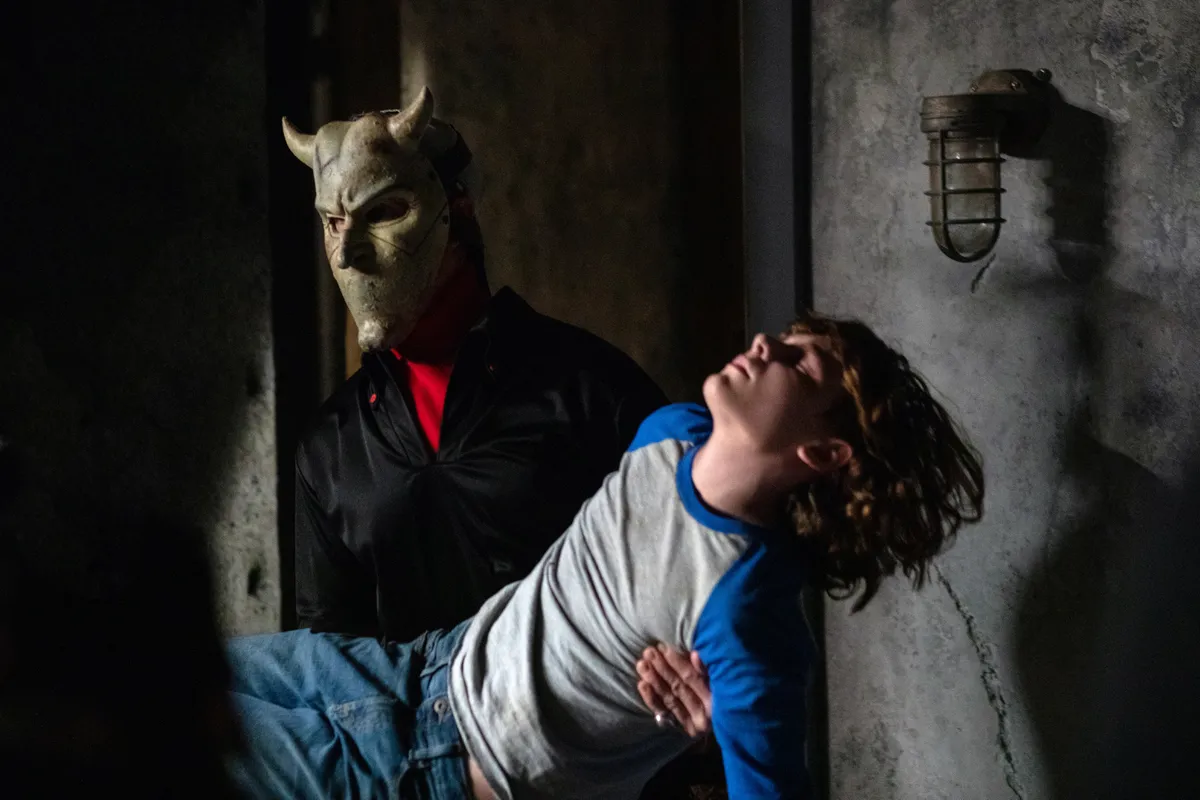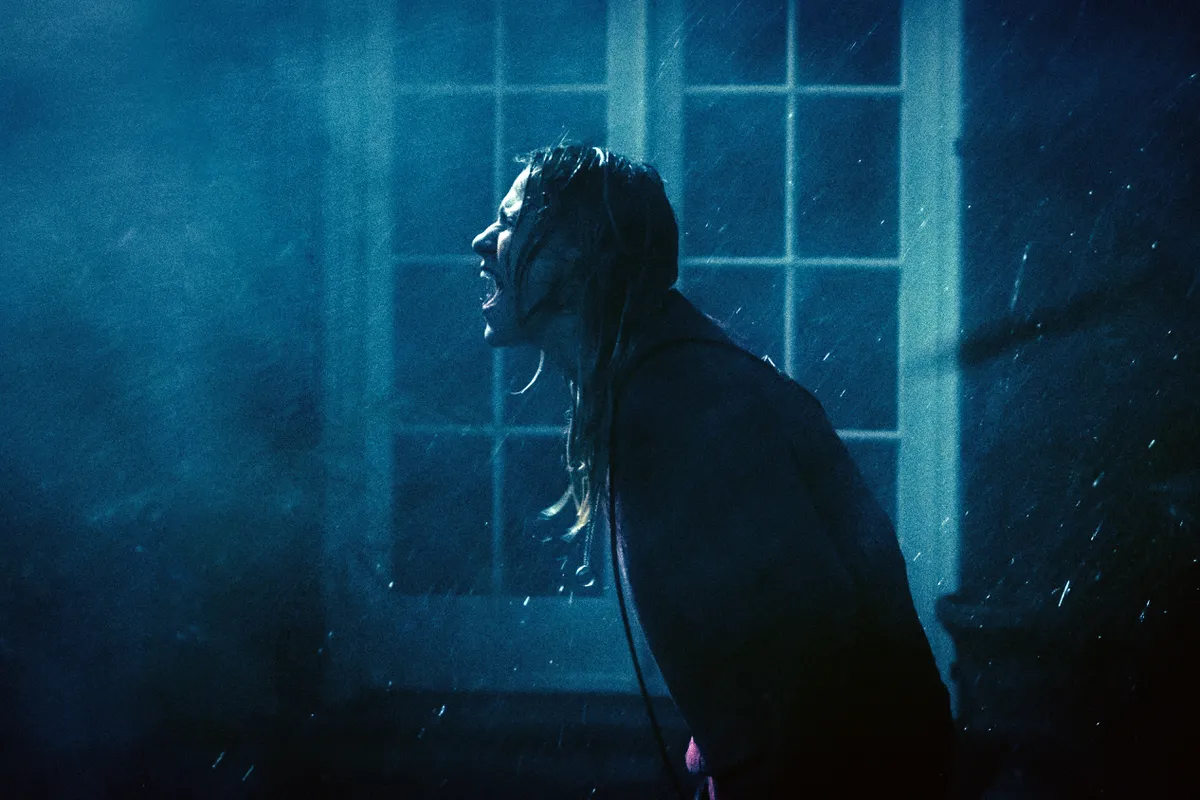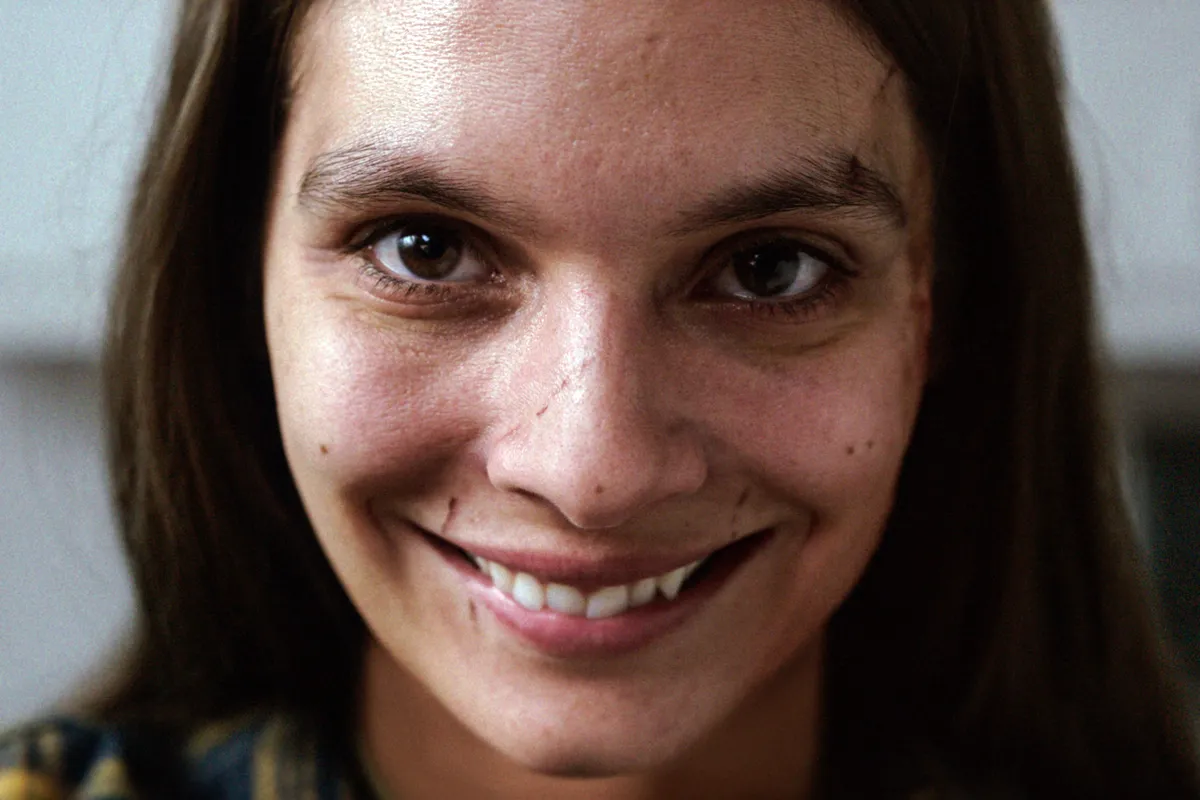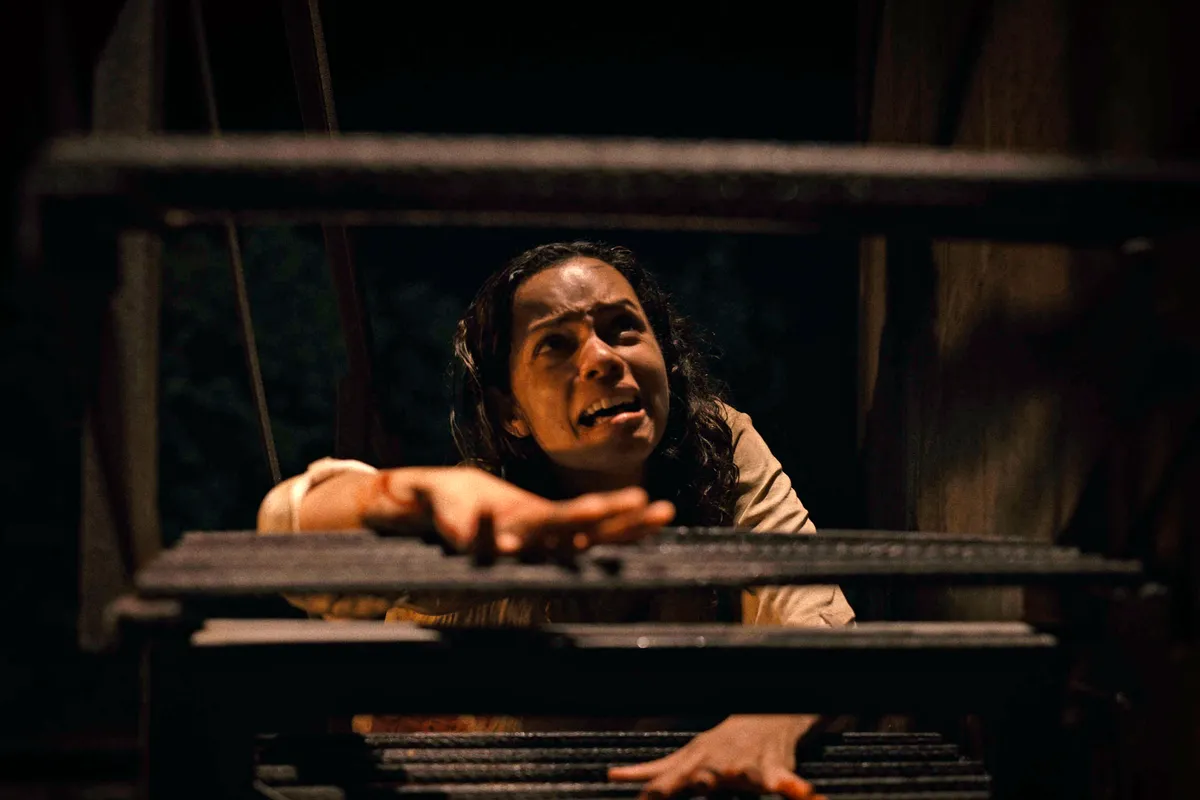
Ethan Hawke and Mason Thames in The Black Phone, directed by Scott Derrickson. FRED NORRIS/UNIVERSAL PICTURES
It has been a good year to be scared stupid.
While the rest of Hollywood has spent the past 10 months anxiously worrying about the states of many genuinely concerning things – the blockbuster, the mid-budget adult drama, the children’s film, the big-screen comedy, the entire business of making and releasing movies, really – the horror industry is over there in a creepy corner, minding its own bloody business. A business that is booming.
This year’s biggest box-office success stories – the kind of come-from-behind surprises that shake the foundations of collective film-industry wisdom – belong almost exclusively to horror movies. The Black Phone was made for just US$16-million, but has earned US$160-million worldwide. Barbarian cost even less, US$4-million, and defied typical box-office rhythms thanks to strong you-won’t-believe-this-movie word-of-mouth that puts the film on pace to make at least 10 times its budget. The nasty little US$17-million thriller Smile, which was initially set to go straight to streaming before Paramount Pictures decided to pivot to a theatrical release, hit US$100-million without breaking a sweat – and in a fraction of the time that it took, say, Brad Pitt’s megabudget Bullet Train to achieve that same milestone.
And that’s not nearly all: There is also Nope, Bodies Bodies Bodies, The Invitation, Ti West’s double-header of X and Pearl. There was even a new Scream movie – released back in January during the depths of Omicron, when barely any theatres were open at all – which went on to earn US$140-million. If we want to be charitable, the year’s best superhero movie, Matt Reeves’s The Batman, can also be considered a horror movie (it’s got a freaky serial killer, lots of dead bodies, so very much rain).
All of these movies have also, more or less, been critical darlings. It is one thing if a big dumb blockbuster puts butts in seats for an opening weekend, quite another when audiences leave the multiplex feeling like they had a genuinely good time and didn’t simply fulfill cinematic-universe continuity obligations. I cannot recall, for instance, the last time I had such a stupidly wide grin on my face as when watching Zach Cregger’s Barbarian – a wild ride that starts off as a creep vs. heroine tale about a woman fending off a slick psycho before turning into a haunted-house thriller before then flipping into something completely new at least three more times. There is value, after all, in shock.
So: Has horror come to save the movie business, in this, its most desperate hour of need? Not really. While it would be easy to say that horror movies are the heroes that Hollywood needs, the scary truth is that it is always a good year for horror. It is the one genre that consistently performs, even if it is always disrespected. The only difference now is that it has taken the entire collapse of the film industry – the pandemic, the streaming wars, the skittishness of studios to make anything not based on franchise-able intellectual property – to realize that fact.
Horror is as old as the history of cinema itself. Georges Méliès, one of the fathers of what we think of as cinema, made a handful of horror films starting with 1896′s The House of the Devil, the earliest known scary movie. Yet the genre has almost as long been considered a disreputable enterprise. With notable exceptions that tend to crop up decades apart – 1973′s The Exorcist, 1999′s The Sixth Sense, 2017′s Get Out – horror movies don’t command awards-industry respect, and are generally thought of cheap, disposable trifles that exist to satiate bored youth until their tastes have matured enough to appreciate “real” cinema.
During the sleazy highs and lows of the grindhouse era of the seventies and eighties – not to mention the days of Canada’s parallel tax-shelter boom – horror might as well have been pornography, with knives in place of other dangerously wielded phallic objects. (This juxtaposition is also the thematic through-line of this year’s sleeper hit X, which cleverly marries horror and porn into one gory tale of cultural outrage.)
But despite the long-held disdain for the genre, we not-so-secretly love horror movies. We always have. Even the most casual moviegoer could handily name-check half a dozen horror films as being among the greatest movies ever made. Psycho. Alien. Night of the Living Dead. Rosemary’s Baby. Carrie. The Shining.
The reasons that horror always hits are half-obvious, half-curious. There are the easy thrills that come with facing the unknown from a safe distance. There is the titillation that comes with watching characters, almost always young and impulse-free doofuses, getting hacked and slashed for their supposed moral trespasses. There is the pleasure of having one part of your brain warning you to not look at the screen, while at the same time other parts of your body – your quickly beating heart, your escalating pulse – pull you in exactly the opposite direction.
There is also the faux-danger paradox: We tend to gravitate toward entertainment that portrays events that are worse than what is going on outside our own window. When the real world is in chaos, there is a distinct comfort to be found in the control that we can exercise over what we consume on our screens.
Horror is also one of the more progressive of genres, with the films acting as cinematic Trojan horses. Filmmakers have used the skin of a horror movie to smuggle in treatises about race (Get Out), consumerism (Dawn of the Dead), political paranoia (The Mist), environmentalism (The Host), the splintering of the modern family (Sinister), creeping American fascism (The Purge series), and on and on. Canada’s new wave of Indigenous filmmakers are particularly adept at finding ingenious ways to address colonialism through horror, including the late Jeff Barnaby, whose zombie thriller Blood Quantum is required watching.
Some of cinema’s finest practitioners either began or continue to work in the horror space: Alfred Hitchcock, Roman Polanski, John Carpenter, David Cronenberg, Sam Raimi, Guillermo del Toro, Jennifer Kent, Kiyoshi Kurosawa, Claire Denis, Park Chan-wook. The powerhouse performances delivered in horror movies during just the past few years – Toni Collette in Hereditary, Lupita Nyong’o in Us, Annabelle Wallis in Malignant, Florence Pugh in Midsommar, Mia Goth in Pearl, Vincent Lindon in Titane – rival any Oscar-certified drama.
But most importantly, at least when it comes to the contemporary movie business, horror gets audiences out of the house and into a theatre. They are a reliable, evergreen line of product – if we have to simplify things to that crass level of consumerism (and these days we really do) – that sustain a theatrical landscape badly in need of any stability it can get. Horror movies perform well during spooky season, of course – this past weekend’s box office was topped by Halloween Ends, followed closely by Smile, Barbarian and then Terrifier 2, a microbudget splatter-fest that has broken out thanks to reports of mid-screening panic attacks by audience members. But horror movies get audiences out just as much in the depths of January or the dregs of August. They are all-season industrial-strength scream machines.
Back in 2015, I had a prophetic conversation with producer Jason Blum (Paranormal Activity), who had just started to establish himself by attracting big names to his on-the-cheap horror movies – his idea being that filmmakers and actors would chose the unlimited creative control of a horror movie for initially low paydays and the opportunity to profit-share on sleeper hits. At the time, Blum noted that horror films were still shaking off their reputation owing to the financial model that he was trying to flip on its head.
“Low-budget movies are not a sexy part of the business. There’s the idea that the more successful you get, the more expensive the movies should be,” Blum told me at the time. “It’s a self-fulfilling thing – when producers get successful, they produce big-budget movies. And if they produce low-budget movies, they’re an afterthought.”
Today, Blum is one of Hollywood’s bona fide superstar producers, with his production company Blumhouse scaring up about US$5-billion at the global box office so far – including this past spring’s The Black Phone.
When this summer’s movie season faced a dry-as-dust third act – with 33 per cent fewer titles being released in theatres compared with 2019 – what movie came to rescue of theatre owners and audiences? That would be the rerelease of Steven Spielberg’s Jaws, which earned an impressive US$5.6-million during its brief revival despite being widely available at home and, you know, 47 years old.
Certainly, there are many bad horror movies that help fuel the genre’s ill reputation – even this year, we’ve seen loads of time-wasters and sloppy franchise extensions (does anyone even remember that there was a new Texas Chainsaw Massacre movie that came out in February, or a new Jeepers Creepers that was dumped on audiences last month?). That is the flip-side nature of the horror game: The movies are simple to produce and simpler to market. Which is why the genre is such a cornerstone of the current streaming wars – what easier way to lure in new subscribers than by flooding the market with horror flicks, even if they turn out to be subpar? That new Texas Chainsaw was a Netflix production, Hulu made a new Hellraiser and even Disney+ got into the action by producing a decades-late sequel to the kiddie horror-comedy Hocus Pocus.
There is even an extremely successful streamer, Shudder, that does nothing but horror – and has quietly been producing, acquiring and distributing the best new independent and foreign-language horror films around, including the V/H/S series, Mad God, Saloum, Hellbender and The Sadness. (A whole other essay could be written about the thrilling, and often very gross, things going on in the world of horror outside of Hollywood, including the current Indonesian boom that includes Impetigore, The Queen of Black Magic and May the Devil Take You.)
The other week, director James Cameron let slip a new teaser for Avatar: The Way of the Water, which comes out Dec. 16 and is by all accounts the most anticipated movie of the year – the blockbuster that will truly save Hollywood’s annus horribilis. But the trailer that really got the internet excited was for M3GAN, a movie about a creepy android doll that turns evil. That film comes out Jan. 6, 2023, the only wide release of that week. I eagerly await the bloody Na’vi-M3GAN battle to come.
BARRY HERTZ
The Globe and Mail, October 27, 2022




